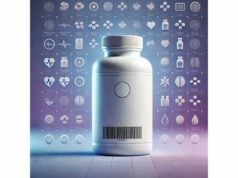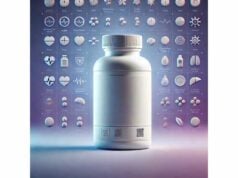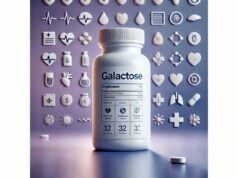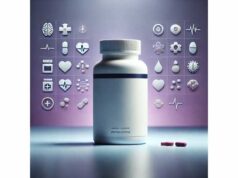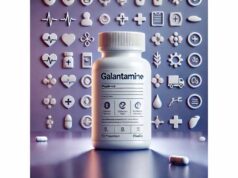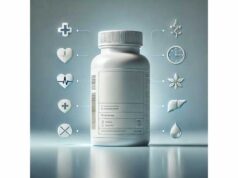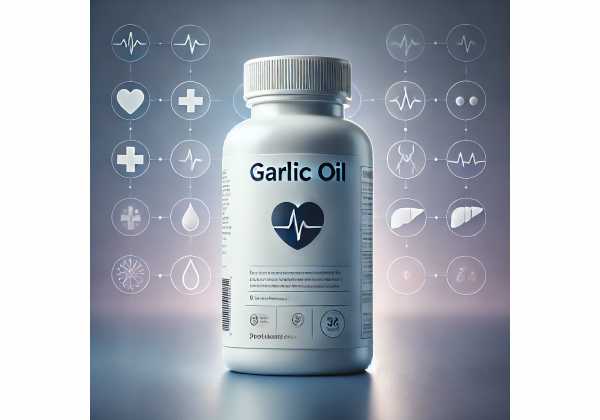
Garlic oil is a concentrated form of the aromatic compounds that give garlic its pungent scent—and much of its biological activity. Extracted primarily by steam distillation or prepared as a macerate in a carrier oil, garlic oil captures fat-soluble organosulfur molecules such as diallyl disulfide and diallyl trisulfide. People turn to it for heart and circulatory support, immune balance during seasonal challenges, and general antioxidant protection. Compared with raw garlic, it is easier to take consistently and avoids the sharp taste. At the same time, garlic oil is not identical to aged garlic extract or garlic powder; each form delivers different compounds and, as a result, the clinical evidence behind them varies. This guide explains what garlic oil is, what it can realistically do, how to choose and use it, recommended dosing, and safety issues to consider before you start.
Quick Overview
- May support cardiovascular health and normal blood pressure when used alongside lifestyle care.
- Delivers fat-soluble organosulfur compounds (e.g., diallyl disulfide), but little to no S-allyl-L-cysteine.
- Typical adult oral dose: 2–5 mg garlic essential oil per day.
- Avoid if you have a garlic allergy or before surgery; talk to your clinician if you use anticoagulants or antiplatelet drugs.
- Not a substitute for prescribed therapy; evidence is strongest for aged garlic extract, not garlic oil.
Table of Contents
- What garlic oil actually is
- Does garlic oil really help?
- How to choose garlic oil
- How to use garlic oil daily
- How much garlic oil per day
- Safety, side effects, and interactions
- Evidence snapshot: what studies show
What garlic oil actually is
Garlic oil is a concentrated preparation made from the bulbs of Allium sativum. Most commercial products use one of two production methods:
- Steam-distilled essential oil. Intact garlic is crushed and distilled. Volatile, fat-soluble sulfur compounds vaporize with steam and are condensed into a highly concentrated essential oil. This oil is then typically diluted into softgels at microgram-to-milligram amounts.
- Oil macerate. Minced garlic is soaked in a culinary or neutral carrier oil; the fat-soluble compounds infuse into the oil. Macerates are less standardized, and—if made at home—can pose safety risks if not acidified and refrigerated properly.
Understanding what’s in garlic oil helps set expectations. When garlic tissue is disrupted, the enzyme alliinase converts alliin into allicin, a reactive molecule responsible for fresh garlic’s bite. Allicin is unstable and rapidly rearranges into organosulfur sulfides such as diallyl sulfide (DAS), diallyl disulfide (DADS), and diallyl trisulfide (DATS), along with related methyl-allyl analogues. Steam-distilled garlic oil is particularly rich in these lipid-soluble sulfides and trisulfides. By contrast, water-soluble compounds like S-allyl-L-cysteine (SAC)—abundant in aged garlic extract—are largely absent from essential oil.
Why does that matter? Different compounds can drive different effects. Water-soluble SAC is the hallmark of aged garlic extract used in many human trials on blood pressure and arterial stiffness. Garlic oil’s DADS and DATS show antioxidant and signaling effects in experimental models and may influence vascular tone and platelet behavior, but the clinical evidence base for garlic oil alone is smaller.
Labels can be confusing. You may see phrases like “equivalent to 500–1500 mg fresh garlic.” This is a marketing equivalency, not the actual amount of essential oil. Regulatory monographs and most clinical texts express garlic oil dosing in milligrams of essential oil per day, not “fresh garlic equivalents.” When comparing products, look for the actual garlic essential oil content per softgel (often 1–2 mg) rather than equivalency statements alone.
Lastly, garlic oil’s sensory profile—the strong aroma some users notice as “garlic burps”—comes from those volatile sulfides. Odor-reduced formulas sometimes encapsulate oil to limit reflux or blend with deodorizing excipients, but potency and tolerability still vary person to person.
Does garlic oil really help?
Short answer: It can help as part of a broader plan, but its specific evidence is modest and not as developed as for aged garlic extract. Most of the strongest clinical data on cardiovascular outcomes (blood pressure, arterial stiffness, certain lipid markers) comes from studies of aged garlic extract (AGE), a preparation rich in water-soluble SAC. Garlic powder tablets also have moderate evidence in some areas. By comparison, human trials that isolate garlic essential oil are fewer and smaller, so conclusions are more cautious.
What you can reasonably expect from garlic oil when it’s used correctly:
- Cardiovascular support (adjunctive). In the context of a heart-healthy pattern—DASH or Mediterranean diet, movement, sleep, and stress control—garlic compounds have been associated with small to moderate improvements in systolic blood pressure and certain lipid measures in research overall. Garlic oil contributes lipid-soluble sulfides that may relax blood vessels (through effects on nitric oxide and hydrogen sulfide signaling in experimental models) and may reduce platelet stickiness. Still, if your primary goal is blood pressure, aged garlic extract has more robust and consistent trial data than garlic oil.
- Antioxidant and inflammatory tone. Organosulfur compounds in garlic oil can upregulate cellular antioxidant defenses and modulate inflammatory signaling in preclinical systems. People often report better tolerance of garlic oil than raw cloves, making steady daily use more feasible if garlic agrees with their stomach.
- Seasonal immune balance. Garlic has a long tradition of use during seasonal challenges. Evidence spans several garlic forms and focuses on symptom days or incidence rather than hard endpoints. Garlic oil may be part of a self-care routine, though it should not replace medical evaluation of persistent or severe symptoms.
- Digestive comfort in some users. Small softgels may be easier on the stomach than raw garlic; others still notice reflux. Taking with food usually helps.
Areas where expectations should be tempered:
- Cholesterol and triglycerides. Findings vary by garlic form and study quality. Improvements are often modest and not a substitute for diet, exercise, or prescribed therapy when indicated.
- Glucose control. Signals exist, but consistency again depends on the preparation used and the population studied.
- Infections. Garlic oil is not a replacement for standard care for bacterial or viral infections. Do not use it as a sole therapy for serious conditions, and do not apply it to open skin or inside the ear canal without medical guidance.
In practice, think of garlic oil as a supportive adjunct rather than a standalone solution. If you need the best-studied cardiovascular outcomes, consider discussing aged garlic extract with your clinician. If you prefer garlic oil for its small capsule size or you tolerate it better, it can still play a role—just align your goals with what the evidence can reasonably deliver.
How to choose garlic oil
The garlic supplement shelf is crowded. Here’s a practical framework to pick a reliable product that matches your goals:
1) Identify the preparation.
Look for clear wording such as “garlic essential oil (steam-distilled)” with the actual milligrams of essential oil per softgel. Avoid products that only state “fresh garlic equivalent” without disclosing the oil content. If the label says “garlic oil macerate” or “garlic in oil,” it’s likely a macerated product with variable composition; prefer transparent, standardized essential oil content when you want predictable dosing.
2) Check the dose per serving—expressed as mg garlic essential oil.
Regulatory monographs commonly reference an adult daily intake of 2–5 mg of garlic essential oil. Many softgels contain around 1–2 mg per softgel, translating practically to 1–3 softgels daily depending on the brand. Choose a strength that makes hitting your target dose simple.
3) Review excipients and allergens.
Garlic oil is typically diluted in a carrier oil (e.g., olive, sunflower, or soy) and encapsulated in gelatin. If you have soy avoidance, look for soy-free formulas. Vegetarians or vegans should check for gelatin and consider alternatives if needed.
4) Odor control and tolerability.
If garlic taste repeats on you, look for “odor-reduced” or “enteric-coated” softgels. The trade-off is that heavy deodorization can sometimes coincide with lower volatile content. If reflux is an issue, try splitting doses with meals rather than taking a large single dose.
5) Third-party testing and supplier transparency.
Trustworthy manufacturers provide lot-specific testing for identity, purity (heavy metals, residual solvents), and microbial quality. Certifications (for example, GMP audits) add confidence. Favor brands that disclose standardization details and contact information for quality inquiries.
6) Storage and packaging.
Light and heat can degrade volatiles. Choose products in opaque bottles, store them cool and dry, and note the expiry date.
7) Avoid homemade garlic-in-oil for long storage.
Raw garlic submerged in oil at room temperature can allow Clostridium botulinum to grow if not properly acidified and refrigerated. Commercial supplements follow safety controls; home infusions require strict food-safety steps and short refrigerated storage. When in doubt, do not prepare or store homemade garlic-in-oil.
8) Match the form to your goal.
- Seeking the best-studied blood pressure support? Discuss aged garlic extract with your clinician.
- Prefer small capsules and fat-soluble actives? A clear, standardized garlic essential oil softgel can fit.
- Want culinary flavor? Use fresh garlic in cooking; do not rely on culinary garlic oil for medicinal dosing.
A bit of label literacy and a focus on standardized oil content will help you get a product that performs as expected.
How to use garlic oil daily
Using garlic oil well is about consistency, context, and comfort. Here’s a step-by-step routine:
Step 1 — Set a realistic goal.
Decide what you’re hoping to support: general cardiovascular health, seasonal wellness, or antioxidant backup during a demanding period. Garlic oil works best as a supporting player, not the star of the show.
Step 2 — Choose a practical dose and schedule.
Start with 2 mg of garlic essential oil per day with food (breakfast or lunch). If you’re tolerating it and want to move toward the top of the commonly referenced range, step up to 3–5 mg/day over one to two weeks. Splitting the dose (e.g., 1–2 mg twice daily) often improves comfort.
Step 3 — Pair with lifestyle fundamentals.
Garlic’s benefits are amplified when the basics are in place: a plant-forward eating pattern with ample vegetables and legumes, sodium awareness, regular physical activity, restorative sleep, and stress reduction. If you already take heart-healthy supplements (e.g., omega-3s) or medications, coordinate with your clinician to avoid overlaps or interactions.
Step 4 — Minimize reflux and odor.
- Take with meals.
- Start low and increase gradually.
- Try odor-reduced or enteric-coated softgels if burps are bothersome.
- Stay hydrated; avoid lying down right after swallowing capsules.
Step 5 — Track meaningful metrics.
For cardiovascular goals, home blood pressure logs (same cuff, same arm, consistent timing) are far more informative than how you feel. For lipid goals, repeat labs on the schedule your clinician recommends. For seasonal wellness, note days with symptoms rather than subjective impressions.
Step 6 — Know what not to do.
- Do not substitute garlic oil for prescribed antihypertensives, statins, antiplatelets, or anticoagulants without medical guidance.
- Do not insert garlic oil or cloves into the ear canal or nose. Ear pain or fullness needs an exam, not oils.
- Do not use homemade garlic-in-oil as a supplement or store it at room temperature.
- For pregnancy, breastfeeding, bleeding disorders, or upcoming surgery, use only with clinician approval.
Step 7 — Reassess at 8–12 weeks.
If your goal is blood pressure support and you’re taking the product daily alongside lifestyle measures, evaluate objective changes at two to three months. If there’s no meaningful benefit—or if side effects persist—consider switching forms (for example, to aged garlic extract) or discontinuing.
Practical, patient use is the difference between “I tried garlic once” and a fair trial that informs your next step.
How much garlic oil per day
Typical adult oral dose: 2–5 mg/day of garlic essential oil. That range reflects authoritative monograph guidance for steam-distilled garlic essential oil used as an oral supplement.
Here’s how to translate that into what you see on a label:
- Find the actual essential oil content. Look for a line such as “Garlic essential oil … 2 mg per softgel.” If the label only boasts “equivalent to 1000–1500 mg of fresh garlic,” call the manufacturer or choose a brand that declares mg of essential oil.
- Match dose to softgels.
- If your softgel contains 1 mg oil, common daily patterns are 2–5 softgels/day, taken with meals.
- If your softgel contains 2 mg oil, common patterns are 1–2 softgels/day.
- Titrate for comfort and goals. Start at the low end (2 mg/day) for a week. If tolerated and your goal warrants it, increase toward 3–5 mg/day. There isn’t evidence that going above 5 mg/day yields additional benefits; higher volatile loads may only increase reflux.
Duration: Many users aim for 8–12 weeks before judging effect, then continue if there’s a measurable benefit and good tolerability. For long-term use, periodic breaks and check-ins with a clinician are prudent.
Special situations:
- Hypertension focus. Most strong blood pressure data involves aged garlic extract at ≥1200 mg/day (expressed as AGE, not oil). If blood pressure is your priority, discuss switching to AGE with your healthcare professional while maintaining diet and medications as prescribed.
- Lipids focus. Effects are modest across garlic forms. Optimize diet (soluble fiber, plant sterols), movement, and sleep first; consider garlic oil as an adjunct if you tolerate it and your clinician agrees.
- Culinary use. Do not assume garlic-flavored cooking oil delivers medicinal dosing. Culinary products vary widely and are not a substitute for standardized softgels.
Who should use different dosing or avoid use:
- Children and adolescents. Supplement dosing for minors should be directed by a clinician; adult ranges do not automatically apply.
- Pregnancy and lactation. Safety data for supplemental garlic essential oil is limited; avoid unless your clinician recommends it.
- Pre-surgical periods. Stop garlic supplements 7–10 days before elective procedures unless your surgeon advises otherwise, due to potential effects on platelet function.
Consistency, clear labeling, and realistic endpoints are the keys to getting dosing right.
Safety, side effects, and interactions
Garlic is a familiar food, but concentrated garlic oil requires the same care you would give any active supplement.
Common, usually mild effects (often dose-related):
- Gastrointestinal: reflux, heartburn, stomach upset, gas. Taking with food and starting low reduces these.
- Breath and skin odor: due to volatile sulfides. Odor-reduced or enteric-coated softgels can help, but some odor is possible.
Less common but important:
- Bleeding risk and platelet effects. Garlic compounds can reduce platelet aggregation. This may increase bleeding tendency, especially during surgery or when combined with anticoagulants (e.g., warfarin, DOACs) or antiplatelet drugs (e.g., aspirin, clopidogrel). People with bleeding disorders should consult a specialist before use.
- Allergy. True garlic allergy is uncommon but real. Stop immediately and seek care if you develop rash, hives, wheeze, or swelling.
- Drug interactions. Besides effects on platelet function, garlic may influence drug metabolism or absorption in specific contexts. If you take antihypertensives, lipid-lowering medications, antiretrovirals, or chemotherapeutics, review your plan with your clinician.
- Pregnancy and lactation. Food-level intake is generally acceptable; supplemental essential oil lacks robust data and should be avoided unless advised by your clinician.
- Diabetes. Garlic can interact with glucose control in some individuals; monitor and coordinate with your care team if you take glucose-lowering medication.
- Topical and ear use. Do not place garlic oil or cloves into the ear canal, particularly if there is pain, drainage, or suspected eardrum perforation. Skin application can cause irritation or burns if undiluted.
Food-safety note about “garlic in oil”:
Storing raw garlic submerged in oil at room temperature can create an oxygen-free environment where Clostridium botulinum may grow, producing a dangerous toxin. Commercial supplements are manufactured under controlled conditions. At home, unless you follow tested, acidified recipes and keep the product refrigerated for a short period, avoid making or using homemade garlic-in-oil.
When to stop and seek help:
- Unusual bruising or bleeding, black or tarry stools, or prolonged nosebleeds.
- Severe stomach pain, vomiting, or persistent heartburn.
- Signs of allergic reaction (hives, swelling, breathing difficulty).
Before you start, talk with your clinician if you:
- Take anticoagulants or antiplatelet medications.
- Have an upcoming surgery, dental extraction, or invasive procedure.
- Have a bleeding disorder, peptic ulcer disease, or uncontrolled reflux.
- Are pregnant, breastfeeding, or planning pregnancy.
Used thoughtfully and with proper precautions, garlic oil can be a safe adjunct for many adults. Respect its biological activity and coordinate with your care team.
Evidence snapshot: what studies show
A balanced look at the research helps set the right expectations:
Blood pressure and cardiovascular markers.
Multiple randomized trials and meta-analyses show that garlic supplements can reduce blood pressure in people with hypertension. The most consistent benefits are seen with aged garlic extract (AGE), often at daily doses above 1200 mg. Average reductions for systolic blood pressure in such studies are commonly in the mid-single-digit mm Hg range, which is clinically meaningful but not a replacement for standard therapy. Garlic powder tablets have also shown benefit in some analyses. Garlic oil alone has less human trial data, so firm conclusions about its comparative effect size are limited. If blood pressure is your primary goal, AGE remains the best-studied form.
Lipids.
Across garlic forms, some analyses suggest small improvements in total cholesterol and LDL-cholesterol, with variability by population and preparation. The magnitude is usually modest; lifestyle change remains the cornerstone of lipid management. Again, preparation matters, and effect sizes cannot be directly extrapolated from AGE or powder studies to essential oil softgels.
Mechanisms relevant to garlic oil.
Garlic oil’s DADS and DATS have demonstrated antioxidant and signaling actions in experimental systems, including effects on vascular smooth muscle tone and endogenous gasotransmitter pathways. They may also contribute to antiplatelet effects observed with garlic supplementation. These mechanistic data are consistent with, but do not replace, clinical outcomes research.
Safety and interactions.
A comprehensive review of dietary supplements and bleeding highlights garlic as one of the supplements with credible evidence of increased surgical bleeding risk, independent of anticoagulants. This underpins the standard advice to pause garlic supplements ahead of procedures and to use caution if you are on medications that affect clotting. Authoritative monographs also set adult dosing for garlic essential oil at 2–5 mg/day and reinforce practical risk statements and labeling.
Bottom line.
- For blood pressure or arterial stiffness, prioritize aged garlic extract (discuss dosing and fit with your clinician).
- If you choose garlic oil, use 2–5 mg/day, align with your goals, and track objective metrics.
- Across all forms, garlic is an adjunct, not a stand-alone treatment. Safety considerations—especially around bleeding—are real but manageable with planning.
References
- NATURAL HEALTH PRODUCT GARLIC – ALLIUM SATIVUM 2025 (Guideline)
- Effects of aged garlic extract on blood pressure in hypertensive patients: A systematic review and meta-analysis of randomized controlled trials 2024 (Systematic Review)
- Garlic consumption can reduce the risk of dyslipidemia 2024 (Systematic Review)
- Biological properties and therapeutic applications of garlic organosulfur compounds 2022 (Review)
- Dietary supplements and bleeding 2022 (Review)
Disclaimer
This article is for informational purposes only and does not constitute medical advice. Garlic oil is not a substitute for professional diagnosis, treatment, or prescribed medications. Always speak with your healthcare provider before starting, stopping, or changing any supplement, especially if you have health conditions, are pregnant or breastfeeding, take medications that affect blood pressure, blood clotting, or cholesterol, or have an upcoming procedure.
If you found this guide helpful, please consider sharing it with a friend on Facebook, X (formerly Twitter), or your favorite platform, and follow us for future evidence-based wellness articles. Your support helps us continue creating high-quality resources.

